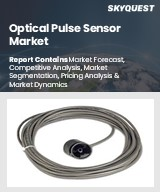
광펄스 센서 세계 시장 규모는 2023년 26억 달러, 2024년 29억 달러에서 2032년에는 69억 3,000만 달러에 이르고, 예측 기간(2025-2032년) CAGR은 11.5%를 나타낼 전망입니다.
세계 광펄스 센서 시장은 웨어러블 헬스 피트니스 기기에 대한 수요 증가와 만성 질환에 대한 인식이 높아지면서 강력한 성장세를 보이고 있습니다. 실시간 건강 모니터링에 대한 소비자의 관심은 건강 추적을 위한 정확하고 비침습적인 솔루션의 채택을 촉진하고 있습니다. 또한, 현재 진행 중인 기술 발전으로 인해 집적화 능력, 소형화 및 감지 정확도가 향상되어 다양한 응용 분야에서 광펄스 센서의 매력이 확대되고 있습니다. 그러나 환경적 요인이나 개인차에 따른 정확도 및 신뢰성 문제 등 센서의 성능에 영향을 미칠 수 있는 문제도 여전히 남아있습니다. 또한, 고급 센서 기술의 높은 비용은 특히 예산에 민감한 소비자들 사이에서 시장 침투의 장벽으로 작용하고 있습니다. 이러한 역학은 광펄스 센서 분야 시장 동향과 전반적인 성장 전망에 영향을 미치고 있습니다.
Global Optical Pulse Sensor Market size was valued at USD 2.6 billion in 2023 and is poised to grow from USD 2.9 billion in 2024 to USD 6.93 billion by 2032, growing at a CAGR of 11.5% during the forecast period (2025-2032).
The global optical pulse sensor market is experiencing robust growth driven by the increasing demand for wearable health and fitness devices and heightened awareness of chronic diseases. Consumers' focus on real-time health monitoring propels the adoption of precise, non-invasive solutions for health tracking. Moreover, ongoing technological advancements enhance integration capabilities, miniaturization, and sensing accuracy, broadening the appeal of optical pulse sensors across various applications. However, challenges remain, including accuracy and reliability concerns stemming from environmental factors and individual differences, which can affect sensor performance. Additionally, the high cost of advanced sensor technologies poses a barrier to market penetration, particularly among budget-conscious consumers. These dynamics influence market trends and overall growth forecasts for the optical pulse sensor sector.
Top-down and bottom-up approaches were used to estimate and validate the size of the Global Optical Pulse Sensor market and to estimate the size of various other dependent submarkets. The research methodology used to estimate the market size includes the following details: The key players in the market were identified through secondary research, and their market shares in the respective regions were determined through primary and secondary research. This entire procedure includes the study of the annual and financial reports of the top market players and extensive interviews for key insights from industry leaders such as CEOs, VPs, directors, and marketing executives. All percentage shares split, and breakdowns were determined using secondary sources and verified through Primary sources. All possible parameters that affect the markets covered in this research study have been accounted for, viewed in extensive detail, verified through primary research, and analyzed to get the final quantitative and qualitative data.
Global Optical Pulse Sensor Market Segments Analysis
Global Optical Pulse Sensor Market is segmented by Type of Sensor, End-User industry, Application and region. Based on Type of Sensor, the market is segmented into Photo plethysmography (PPG) Sensors, Photodiode Sensors and Pulse Oximetry Sensors. Based on End-User industry, the market is segmented into Healthcare, Sports and Fitness, Automotive and Consumer Electronics. Based on Application, the market is segmented into Smartwatches, Sports equipment, Smartphones and Tablets. Based on region, the market is segmented into North America, Europe, Asia Pacific, Latin America and Middle East & Africa.
Driver of the Global Optical Pulse Sensor Market
The increasing popularity of health and fitness wearables significantly drives the global optical pulse sensor market, as these devices rely on optical pulse sensors for real-time monitoring of vital signs such as heart rate and pulse. A heightened awareness of health issues, alongside the rising prevalence of chronic diseases and the demand for continuous personal health tracking, has fueled the adoption of optical pulse sensors. This surge in use has contributed to the overall growth of the market, enhancing its size, share, and revenue on a global scale, as more consumers seek innovative solutions for health management and wellness.
Restraints in the Global Optical Pulse Sensor Market
The global optical pulse sensor market faces significant challenges due to concerns over accuracy and reliability. Various factors such as ambient light interference, motion artifacts, and variations in skin pigmentation can adversely affect sensor performance, leading to inconsistent or incorrect readings. These limitations undermine user trust and hinder the widespread adoption of these sensors in essential health monitoring applications. This is particularly critical in situations where precise, real-time data is vital for clinical decision-making and personal health management, ultimately impacting the growth and acceptance of optical pulse sensor technology in the healthcare landscape.
Market Trends of the Global Optical Pulse Sensor Market
The Global Optical Pulse Sensor market is experiencing robust growth driven by the rising adoption of wearable devices. Smartwatches, fitness trackers, and advanced health monitoring gadgets are increasingly integrating optical pulse sensors to provide real-time tracking of vital signs, reflecting heightened health awareness among consumers. This trend is further supported by the escalating demand for continuous health monitoring, along with advancements in sensor miniaturization and precision, which enhance user experience. As manufacturers innovate to meet these needs and expand their product offerings, the market is poised for significant expansion, catering to a growing demographic that prioritizes health and fitness management.